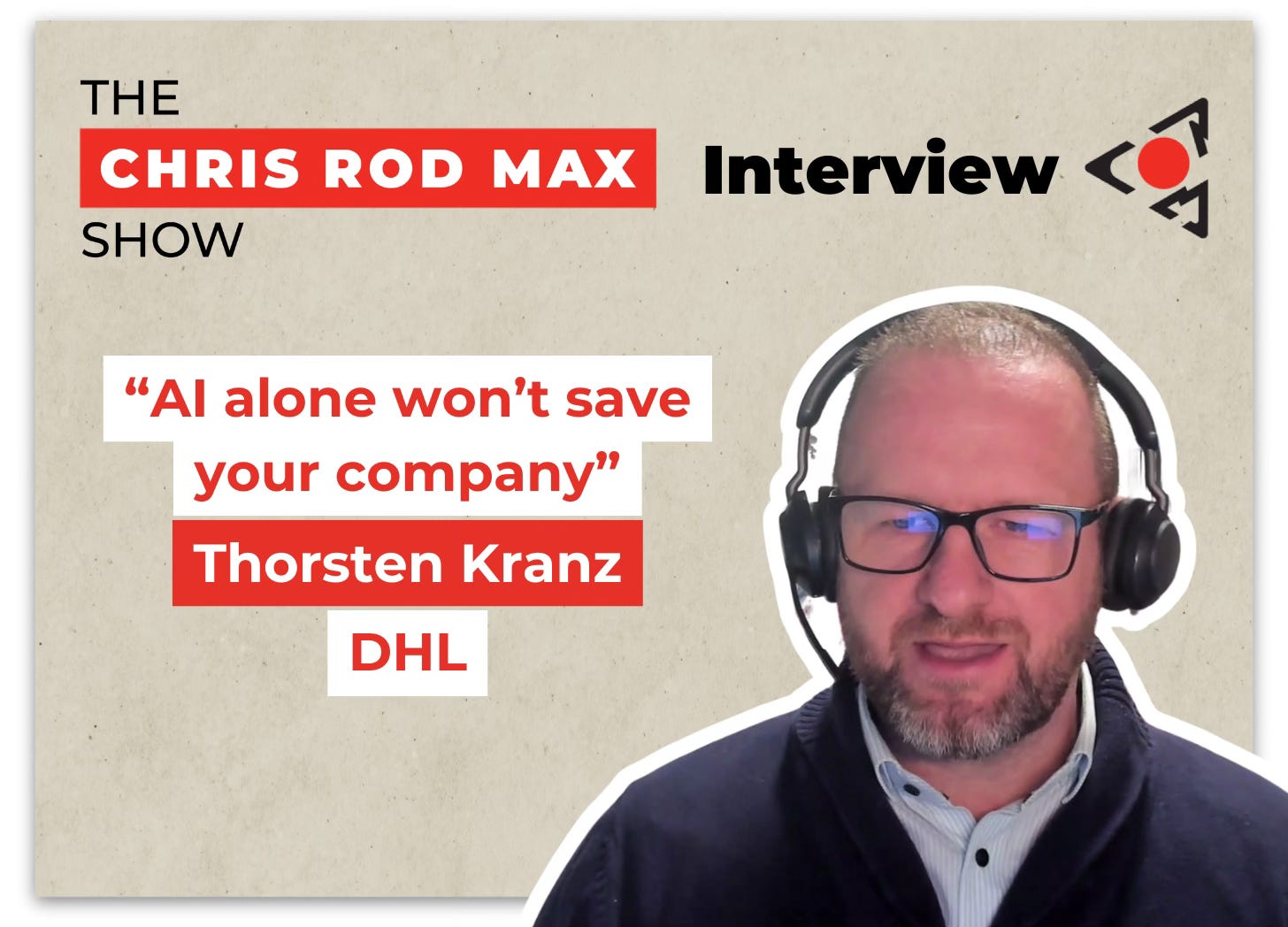Thorsten Kranz, head of AI solutions at DHL Group, joins Chris Rod and Max in this episode. They explore the challenges of AI adoption, the importance of data quality, and the impact of AI on various business functions.
The conversation also delves into investment trends in AI, the decision-making process between building or buying AI solutions, and the potential disruption of jobs across multiple industries due to AI advancements.
In this conversation, Thorsten Kranz discusses the evolving landscape of AI, its applications across various industries, and the implications for the job market. He emphasizes the importance of adaptability and continuous learning in the workforce, as well as the need for managers to lead by example in adopting AI technologies.
The discussion also touches on the challenges posed by AI in terms of skill gaps and the potential for societal divides based on AI literacy.
Chapters
00:00 Introduction to AI in Enterprises
02:51 AI Adoption and Organizational Readiness
06:34 Data Quality Challenges
10:10 Interactive Data Analysis and User Engagement
17:17 AI’s Impact on Business Functions
21:09 Investment Trends in AI
25:38 Building vs. Buying AI Solutions
30:39 The Future of Jobs in the Age of AI
31:58 Exploring AI Use Cases Across Industries
35:27 The Future of AI and Job Market Dynamics
41:13 Hiring for the AI Era: Skills and Mindset
47:30 Practical Applications of AI in Management
55:45 Final Thoughts on AI’s Rapid Evolution
Takeaways
AI adoption requires robust organizational foundations before meaningful benefits can be realized: While many companies are rushing to implement AI solutions post-ChatGPT, Thorsten emphasizes that success depends on having proper data infrastructure, consistent management practices, and organizational readiness in place first, noting that without this groundwork, companies won't see the expected returns on their AI investments.
The future workforce will likely split between AI-dependent workers and AI-proficient specialists: Thorsten predicts a significant bifurcation in the job market where most workers will heavily rely on AI tools without deep understanding, while a minority who truly comprehend and can go beyond AI's capabilities will command premium compensation, potentially leading to wider economic disparities that might necessitate solutions like universal basic income.
Technical leadership in AI requires hands-on engagement and continuous learning: Drawing from his personal experience, Thorsten emphasizes that effective AI leadership isn't just about directing others - it requires leaders to actively use and understand AI tools themselves, maintain technical proficiency, and constantly experiment with new capabilities, suggesting that theoretical knowledge alone isn't sufficient for guiding AI transformation.
YouTube Episode
Spotify Podcast
Transcript
Chris: Hello everyone, welcome to another episode of the Chris Rod Max show. Every week, we discuss the latest news trends and dynamics within the AI space with distinguished guests. Today, I'm delighted to be joined not only by Rod and Max but also by Thorsten Kranz, Head of AI Solutions at DHL Group. Thorsten, welcome to the show.
Thorsten Kranz: Hi, and thank you for having me. I'm looking forward to our discussion.
Chris: Before we dive into today's fascinating topics, could you share a brief introduction about yourself and your background?
Thorsten Kranz: Of course. At DHL, I manage all aspects of AI, which has become increasingly intense over the past two to three years. My journey in AI began with physics studies, followed by neuroscience research around 2007, where I applied artificial intelligence to understand natural intelligence. Later, I joined a consultancy as their first data scientist, building machine learning solutions across various industries. The team grew rapidly – from just me to 20 people in two years, eventually expanding to a department of 50.
I then decided to move from consulting to join a company's long-term journey, which led me to DHL. While I'm now in management, I'm still a technical person at heart who loves to code and work with data. I've found a way to combine both passions in my current role.
AI Implementation and ROI in Enterprise
Chris: That's fascinating. You've truly been a trendsetter as one of the first data scientists in your company. Today, we'll explore three main topics: your perspective on AI in enterprise, careers and jobs in the AI era, and your personal experience with AI implementation. Let's start with a recent Lenovo report about AI's return on investment.
The statistics show that 26% of adopters say AI projects have exceeded expectations, while about 70% report met expectations. However, many organizations haven't adopted AI solutions yet – 25% are still in pilot phases. A major obstacle seems to be low organizational readiness in terms of data, processes, and IT infrastructure. Thorsten, what's your reaction to these findings?
Thorsten Kranz: These findings aren't surprising. Since ChatGPT's release, we've seen many unrealistic expectations. Some companies are just starting their AI journey, while others may have neglected fundamental work on data consistency, proper management, and organizational structure.
Without proper groundwork, you won't see benefits. At DHL, like many companies, we've been working in this field long before ChatGPT. You need to prepare your organization and IT infrastructure, including MLOps capabilities to easily transfer proofs of concept into production scenarios. This includes monitoring, logging, and support infrastructure.
Even with the advent of large language models, core requirements haven't changed. You still need to integrate AI into your processes and ensure people understand and use the tools effectively. If you're just starting now, there's still significant work ahead.
Data Quality and Organizational Challenges
Chris: That makes sense – you need strong foundations, particularly data quality. I remember a meme about people thinking ChatGPT is magic, but with poor data, you'll get poor results. What makes it so difficult for organizations to maintain good data quality?
Thorsten Kranz: There's no single answer – organizations vary greatly. An e-commerce company with one business model might have relatively simple data needs: website usage and stock information. But historically established companies, especially in Europe, face different challenges with thousands of legacy systems and various potentially relevant datasets.
You need clear prioritization, focusing first on the most valuable data likely to provide ROI. In my experience, initiatives solely focused on improving data quality or governance typically fail. Data quality improves through data usage – only when poor data impacts results do organizations make improvements.
It's best to work iteratively: improve data quality, use the data, identify issues, return to improve the data, and modify the processes that generate the data. This creates an upward spiral of continuous improvement rather than a long-planned program.
Legacy Systems and Modern AI Integration
Rod: Regarding legacy systems, how do organizations make diverse, possibly outdated data sources available to users, especially for AI applications?
Thorsten Kranz: It's an ongoing challenge. Years ago, the reporting world evolved with dashboards for everything – now people need dashboards just to navigate their dashboards. The promise of accessible data has become a maze.
We're seeing a shift toward interactive data analysis for non-technical users, especially with large language models and chat-style interfaces. This allows spontaneous access to insights like employee demographics or gender ratios at different management levels. Rather than creating another dashboard, we're enabling direct data access and insights.
User Adoption and Training
Rod: Some users struggle with formulating thoughts in text prompts. How do you help users interact with these open systems effectively?
Thorsten Kranz: We tackle this from multiple angles. We've invested heavily in training and enablement. Before ChatGPT, we rolled out extensive data science training, including full-day management sessions that thousands of managers have completed. Tens of thousands of employees have completed e-learning courses on data concepts and quality.
With ChatGPT and newer tools, we've established additional training formats. Beyond awareness sessions, we provide dedicated training on understanding large language models' capabilities and limitations. We teach prompting techniques, though newer models like Claude-3 and DeepSeek R1 often understand intent better than earlier versions.
ROI and Business Impact
Chris: Speaking of return on investment, which business functions have shown the highest potential for AI-driven returns?
Thorsten Kranz: Customer service is an obvious area, particularly verbal and written communication. The natural feel of advanced voice models from ChatGPT, Gemini, and others is impressive. Most organizations haven't fully leveraged this technology yet.
However, commercial considerations are important. Some vendor rates are below European labor costs but above offshore rates. We need to ensure AI gains benefit us rather than creating vendor dependencies that consume the ROI.
Beyond customer service, AI shows promise in scalable, repetitive, text-based tasks. But everything must be digital first – many companies still struggle with end-to-end digital processes and documentation. Only with digital historical examples can AI learn and automate effectively.
AI Investment and Infrastructure
Chris: Regarding AI investment, major US tech companies are pouring money into AI – about 63% of their spending. Industry-wide, nearly 20% of tech budgets in 2025 will go to generative AI. What are these investments focusing on?
Thorsten Kranz: The biggest investment is in GPUs. For example, xAI reportedly has 100,000 H100 GPUs and may double that soon – investments on par with major German company valuations. This explains NVIDIA's dramatic share price growth.
Beyond hardware, talent is crucial. We're seeing a talent war with incredible salaries for experts. Infrastructure is another challenge – companies are even investing in dedicated nuclear plants for AI computation centers.
The most investment goes into training foundational models, which increasingly become low-cost or free to use. Value creation may shift to the application layer – applying these models to specific domains like IT ticket resolution. The question is how much of the savings will benefit end-users versus vendors and model creators.
Build vs. Buy Decisions
Max: How do you decide between building AI solutions internally versus using vendors?
Thorsten Kranz: For smaller companies, I strongly recommend against building too much internally. Creating a prototype is relatively easy, but scaling and maintaining it requires substantial infrastructure. Get help from partners – they don't have to be big tech companies; smaller consultancies can work well.
At DHL's scale, we have large teams and experienced colleagues, but our decision process is complex. For standard tasks, we expect multiple vendor solutions, giving us negotiating power. More importantly, we focus on logistics-specific niches where vendor solutions don't exist, like customs clearance automation.
Future of Jobs and AI Impact
Chris: There's an interesting A16Z article listing top 50 jobs that could be AI-automated, spanning architects, financial analysts, dental services, and more. What's your perspective on this widespread potential disruption?
Thorsten Kranz: I believe any limitation of AI will vanish over time. Everything humans can do, AI will eventually be able to do. The best response is to actively engage and shape developments. While I support some regulation, the European approach may limit innovation, especially for smaller companies.
Advising my children (12 and 15) about careers, jobs heavily reliant on personal relationships may be harder to replace. The key is staying curious, open-minded, and accepting that careers will require continuous adaptation.
AI Literacy and Social Impact
Rod: Studies suggest we're becoming "AI illiterate" by relying on answers without understanding. Your thoughts?
Thorsten Kranz: It's a real challenge requiring awareness and reflection. For some areas, like calculator use, we've accepted automated results without verification. I expect a bifurcation: most people will rely heavily on AI, while a minority will maintain deeper understanding.
This creates societal challenges – why pay high salaries to those who simply rely on AI? The minority who go beyond AI's capabilities will command premium compensation. This could widen economic gaps, making universal basic income more relevant as value creation concentrates among a small workforce segment.
Personal AI Usage and Leadership
Chris: How do you personally use AI in your daily work?
Thorsten Kranz: Managers must lead by example – I've seen many urge teams to use AI while barely understanding it themselves. I maintain "street credibility" by actively using various AI tools and subscriptions, comparing capabilities like voice modes between ChatGPT and Gemini.
My most important use is organizing thoughts and converting abstract ideas into actionable plans. Using voice mode or transcription, I can dump thoughts into AI systems, which help structure them, add external knowledge, and create presentation outlines. This has transformed my approach to new concepts – what might have taken a day now takes 30 minutes.
I never start texts from scratch anymore, and I regularly experiment with AI development to understand implementation challenges. There's hardly anything I do without AI these days.
Balancing Technical and Management Roles
Rod: How do you balance hands-on technical work with management responsibilities?
Thorsten Kranz: It's challenging – my coding often happens late at night due to "revenge bedtime procrastination." This is only possible because it's my passion. My day prioritizes work, then family, and finally technical exploration when energy permits.
AI and the Next Generation
Max: How are your children using AI?
Thorsten Kranz: They use AI more thoughtfully than most their age, given my guidance. They use it for schoolwork but not to complete assignments – rather as a learning aid and orientation tool. It's about using AI as a buddy while maintaining independent thinking.
Closing Thoughts
Chris: Any final thoughts on AI and its future?
Thorsten Kranz: Three key points:
AI's power is no longer on the horizon – it's happening now. Showing today's models to someone from three years ago would seem like AGI.
Don't be fooled by specific failures. AI's capabilities are unevenly distributed – it may fail at simple tasks while surpassing PhDs in complex domains.
The future is uncertain – we don't know where value creation will concentrate or what will be possible. We must stay adaptive personally and organizationally.
Chris: Thank you for these insights, Thorsten. The key takeaway seems to be "lead in rather than ignore and stay nimble." How can our audience reach you?
Thorsten Kranz: You can find me on LinkedIn and other typical channels. Happy to connect.
Chris: Thank you everyone. If you enjoyed this episode, please subscribe to the chrisrodmax.com newsletter and channels.
Your Hosts
Christine Wang: https://www.linkedin.com/in/christinewang0/
Rod Rivera: https://www.linkedin.com/in/rodriveracom/
Maxson J.Y. Tee: https://www.linkedin.com/in/maxsontjy/
Social: X: https://x.com/chrisrodmax
Instagram: https://instagram.com/chrisrodmax
LinkedIn: https://linkedin.com/company/chrisrodmax
Subscribe: https://chrisrodmax.com
Tags: #chrisrodmax #ai #technews














Share this post